Well, this article starts a new series which can
be called a testing report. We decided to stop describing new products
over and over again if they differ from the old ones only in an
increased frequency. For example, is there any difference between
a Celeron 1300 and the Celeron
1200 MHz? No. Well, then isn't it better to give just a link
in the very beginning without beating the air?
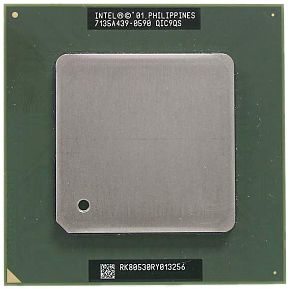
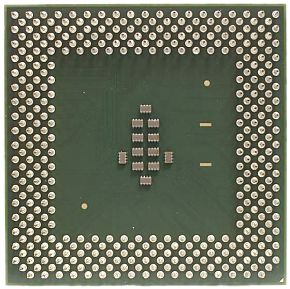
If it's unnecessary to theorize too much and if
you want only performance results we should never go into unnecessary
detail. And for a start we will take the processors which are very
famous and much written about:
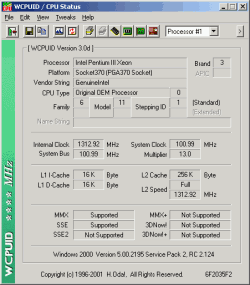
- Intel Celeron ("Tualatin" Core) 1200 MHz (1.2 GHz);
- Intel Celeron ("Tualatin" Core) 1300 MHz (1.3 GHz);
- AMD Duron ("Morgan" Core) 1100 MHz (1.1 GHz);
- AMD Duron ("Morgan" Core) 1200 MHz (1.2 GHz).
Intel platform:
- ASUS TUSL-2C
mainboard (i815 B-Step);
- 256 MBytes PC133 CAS2 SDRAM (Tonicom);
- ASUS V8200 Deluxe (nVidia GeForce3);
AMD platform:
- Gigabyte
GA-7VTX-P mainboard (VIA Apollo KT266A);
- 2x128 (256) MB PC2100 DDR SDRAM (Corsair);
- ASUS V8200 Deluxe (NVIDIA GeForce3);
Other components are standard. The only thing I'd
like to comment on is a choice of the DDR platform for the AMD Duron.
We just have no time to test both platforms, considering that a
close review of PC133 and PC2100 on the Athlon XP and Duron will
soon be finished. As for the Celeron, it will hardly benefit from
DDR memory, and it's better to take the time-proved i815.
Below you can look at the characteristics of the
Duron based on the Morgan core:
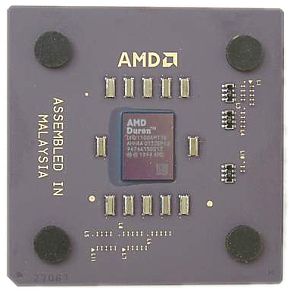
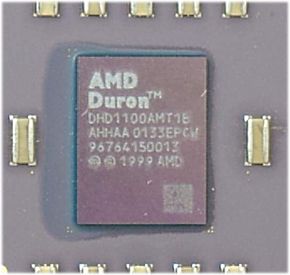
- it, in fact, is Palomino, i.e. Athlon XP;
- unlike the Athlon XP - there is only 64 KBytes L2 Cache;
- unlike the Athlon XP - a 200 MHz FSB;
- unlike the Athlon XP - a complete transition to copper is not
finished yet;
- unlike the Athlon XP - in a usual ceramic package, and, therefore,
a CPU multiplier can be unlocked the usual way.
Test results
3DMark 2001
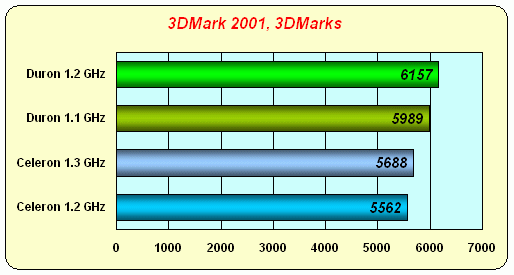
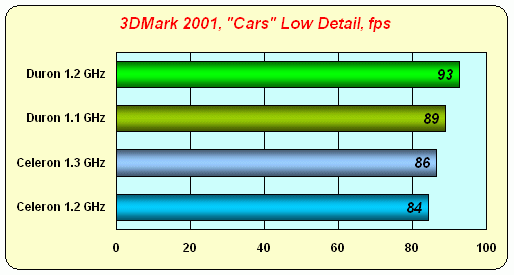
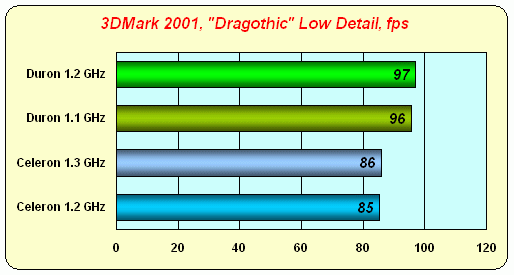
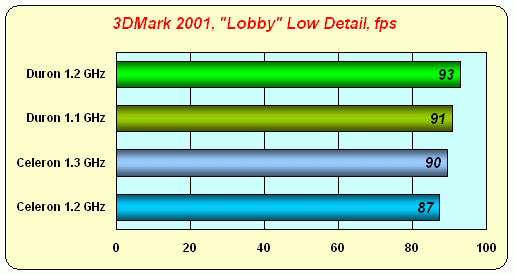
The general scores reflect the tendency of the
two gaming tests out of three. Only in Dragothic the Duron looks
even more better than in the others. But as the performance of the
Celeron 1.2/1.3 GHz and Duron 1.1/1.2 GHz in the Dragothic is almost
the same, and the performance of the AMD platform is much higher
than that of the Intel, we are probably comparing the memory subsystems
rather than the processors. In all other cases the situation is
clear: the Celeron 1.3 GHz is outscored even by the Duron 1.1 GHz.
At such a frequency a speed at which data are pumping through the
processor bus matters a lot, and the Duron with its DDR-like EV-6
bus gets a significant advantage.
Quake III
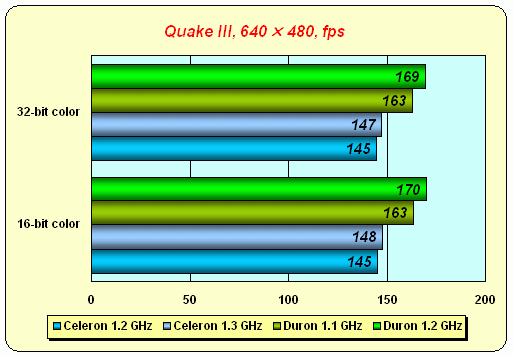
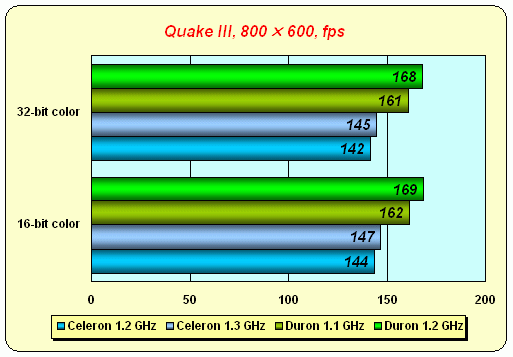
Here the performance gain of the Duron 1.2 GHz
over the Duron 1.1 GHz is higher than that of the Celeron 1.3 GHz
over the Celeron 1.2 GHz. The Celeron is limited by the speed of
operation with RAM, and increasing of the core clock speed may have
no effect in some applications.
Expendable

The situation is just the same as in the 3DMark
2001. The increased frequency of the Celeron's core still makes
an effect, but how strong it is depends on an application.
SYSmark 2001
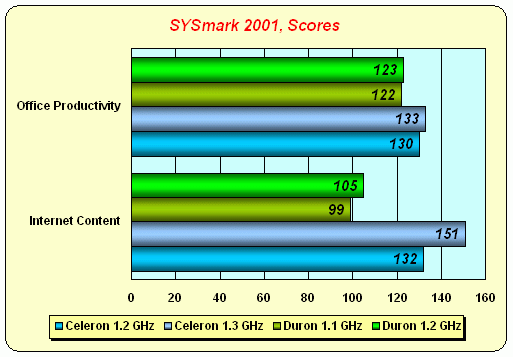
As you know the applications of the BAPCo are Intel-oriented.
But it seems that not only Windows Media Encoder forgets about the
SSE of the Morgan/Palomino based AMD processors, otherwise it would
be difficult to explain the results. Well, if such popular applications
as those included into the SYSmark 2001 show such results, it will
be safe to say that others will demonstrate the same.
eTestingLabs Winstone 2001
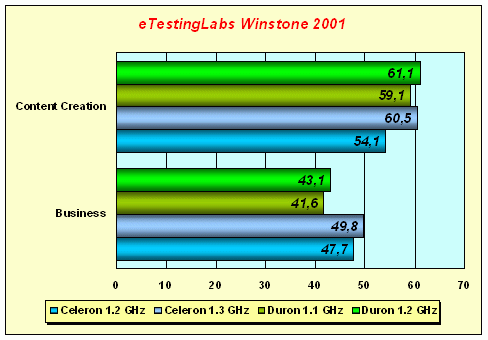
The result is more verisimilar, but the AMD still
loses in the Business subtest.
SPEC ViewPerf
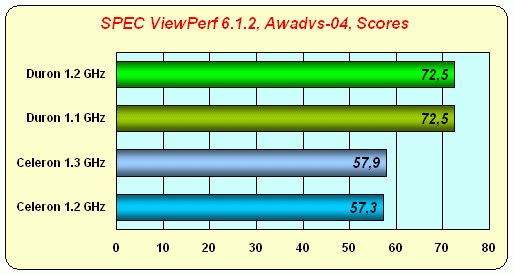
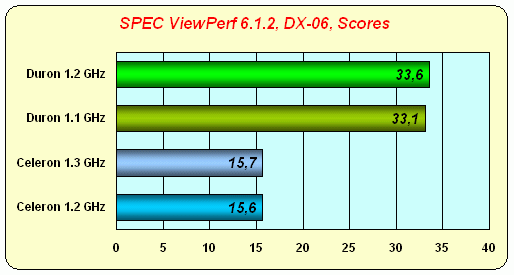
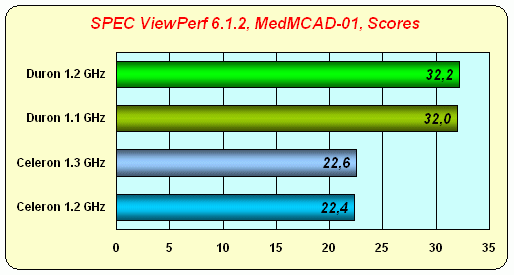
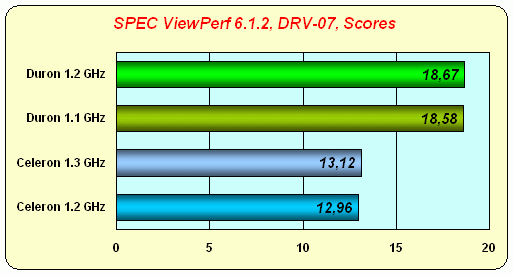
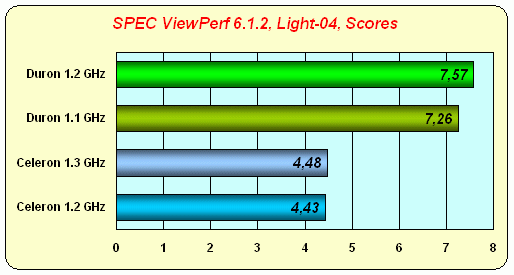
For calculations the most important thing is a
fast memory, a powerful FPU and a classical processor architecture.
That is why the Duron thrives, and the Celeron loses the battle.
3DStudio MAX
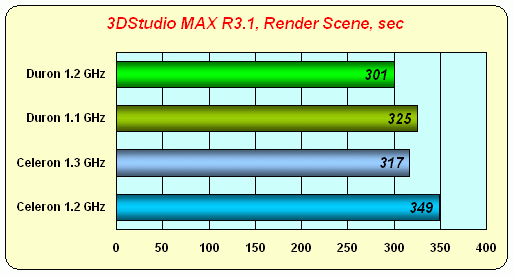
The shorter bar is better. And the Duron again
shows merits of its architecture: the Celeron operating at 1300
MHz hardly catches up with the Duron 1100 MHz, and the Duron 1.2
GHz comes out a leader.
Conclusion
Intel keeps on producing Celerons and selling them
at quite low prices as the cheapest Pentium 4 even with the dead
PC133 version of the i845 doesn't fit in a low-end market. Step-by-step
frequency growth of this processor just doesn't let others forget
about this company. Thus, a 1200 MHz version must be followed by
a 1300 MHz one otherwise you may think that the company gives up.
A real performance here is not an issue of great importance.
On the other hand, the Socket 370 platform beats
the Socket A + Duron in some applications as the software was developed
for a long time with this platform (or, rather, Slot 1) in mind.
The champion in the low-end market is undoubtedly
AMD Duron. And as a DDR platform can be of real use for this processor,
it makes sense to increase its frequency further. And then, if we
get an Athlon with a 166 (333) MHz FSB, a 133 (266) MHz FSB Duron
can be expected as well :)
Write a comment below. No registration needed!




















